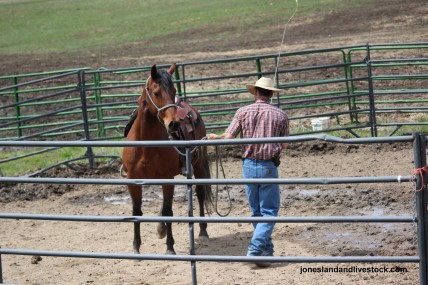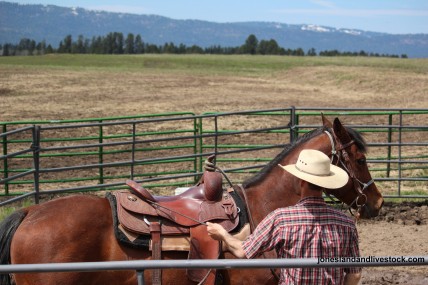
If you are someone who is starting to work and ride your horse after a long winter, there are some important things you need to remember as you get your horse back into shape for the summer riding season.
Remember to establish yourself again as the one in charge and regain your horses respect. Horses especially need to be reminded this if it has been awhile since you worked with your horse. Horses are constantly testing the pecking order looking for opportunities to move up. A few simple exercises with you dictating your horses movements will do the trick of keeping you on top and by default safer. Even when you are simply leading the horse from one place to another, don’t let the horse crowd into your space. It is so important for your horse to respect your space. Horses that crowd your personal space DO NOT respect you and will eventually hurt you. If they come too close to you while you are walking, stop and back them off before you continue walking again. By controlling a horses movements you gain control of their feet. When you have control a a horses feet you have control of their mind.
Start off in the round pen first before you take your horse out into an open arena or an open field. If your horse is anxious or energetic you may want to start with the saddle off while doing your groundwork. If your horse is calm and experienced you might choose to skip ahead and put on the saddle and do your ground work with the saddle on. If you horse has been known to pull back, it is a good idea to saddle up while just holding the lead rope with your horses nose tipped slightly toward you. This way your horse will be able to rotate around you and will not feel trapped. A trapped horse will become anxious often resulting in pulling back or other dangerous behavior. If you horse steps away from the saddle, just follow them as they rotate around you until they stop, then praise and rub them and then throw the saddle on. This is demonstrated in more detail in our: Saddling Video on the Training Videos Page.
Here is the type of ground work you will want to do before you get on your horse:
1. Work out your horse first by lunging it in a circle. It’s important for your horse to get out their nervous energy. Start with a walk and then transition to a trot and then lope. You’ll find that many horses will buck when they first lope with the saddle on after a long layoff. Continue to drive them forward until they get it out of their system and then they are ready to focus and work.
2. Make sure your horse is “Joining Up” with you or “Hooking On”. Meaning, you have their attention (eyes and ears) and when you stop them they turn and face you and focus their attention to you. This is an important step in establishing respect and getting them tuned into listening to your direction. If they won’t focus and follow your direction on the ground, they won’t when you are in the saddle. Several demonstration videos of different exercises that work well in gaining control on the ground are available on the Training Videos Page.
3. Another important part of groundwork before getting on your horse is desensitizing them to different stimuli so that they are less likely to spook and leave you alone hobbling back on foot. One method of desensitizing is accomplished by waving objects around their head and body until they stop reacting to it and then rubbing the same object on their body until they become comfortable with it. Again, allow the horse the freedom to move their feet and not feel trapped. As soon as the horse stops and stands, you can suspend the stimuli as a reward for standing still. Do not stop while the horse is moving or you will teach them to move. You want to get to a point with your horse that they don’t react to you waving those objects.


4. Flexing.
This is where you practice with the horse on being supple in every direction. You’ll see that this exercise helps the horse be supple and responsive to the bit.
In these pictures you see that Josh will wrap the rein behind the cantle of the saddle and pull on it directing the horse to follow his nose turning away from you turning 270 degrees and facing back up to you and consequently finding the release of pressure. This exercise is a good indicator of how well your horse will listen to the bit once you are on board.
Another thing to check is to make sure they are supple vertically when you pull on both reins. Do this on the ground before trying it in the saddle.
5. Before you fully mount your horse, check to make sure how your horse responds to your weight again. Put just the toe of your boot in the stirrup stand leaning over the horse to balance your weight. Rub your horse all over to build their confidence. Keep the near side rein short and their nose tipped toward you. If your horse moves, try to stay in the position pictured at the right with the nose tipped to the near side. This will keep the horse from bolting and running off with you or kicking you if you have to step down. If you can stay in this position until your horse stops moving and then step down, it will go a long way to building their confidence and a willingness to stand while you mount.
Remember horses are two-sided. What you do on one side, always do on the
other.
When it comes time to ride your horse, make sure you work on getting your horse to keep its neck and head head down in a level and plumb carriage position. In this position you will have far greater control then when a horse raises its head and neck.
Ride in the round pen for a while transitioning through all the gates. when first going through the gates, sit relaxed and allow the horse to follow the perimeter of the pen without trying to do much guiding. Keep your outside hand on the horn to help keep your balance and your inside hand on a short rein ready to pull your horses head around and stop them if things start to get too lively.
Then work on guiding and make sure the horse is listening and responding.
At this point you are ready to take him into the arena or out on the trail. More information and demonstrations are available in our Training Tips Videos on the Training Videos Page. If you have any questions or would like to request a video on a specific issue, please contact us. Happy Trails.
I have been out of saddle for about 30 years, and I have found your simple straight forward information to be the best refresher available.
I live in TN and after 4 trainers I have come to the conclusion that no one in this state has a clue about Western riding! After a collective $3,000.00 wasted I am so so glad to have found y'all. Reminds me of my Dad's instruction when he taught me to handle horses & ride. Thanks!